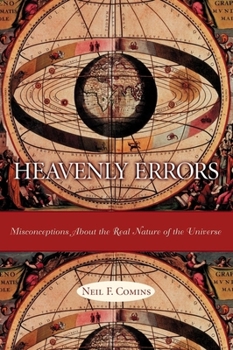Heavenly Errors
Select Format
Select Condition 
Book Overview
One of the great paradoxes of modern times is that the more scientists understand the natural world, the more we discover that our everyday beliefs about it are wrong. Astronomy, in particular, is one of the most misunderstood scientific disciplines. With the participation of thousands of undergraduate students, Neil F. Comins has identified and classified, by origin and topic, over 1,700 commonly held misconceptions. Heavenly Errors provides access to all of them and explores many, including: - Black holes suck in everything around them. - The Sun shines by burning gas. - Comets have tails trailing behind them. - The Moon alone causes tides. - Mercury, the closest planet to the Sun, is the hottest planet. In the course of correcting these errors, he explains that some occur through the prevalence of pseudosciences such as astrology and UFO-logy and some enter the public conscience through the "bad astronomy" of Star Trek, Star Wars, and other science-fiction movies.. Perhaps most important, Professor Comins presents the reader with the methods for identifying and replacing incorrect ideas--tools with which to probe erroneous notions so that we can begin to question for ourselves... and to think more like scientists.
Format:Hardcover
Language:English
ISBN:0231116446
ISBN13:9780231116442
Release Date:August 2001
Publisher:Columbia University Press
Length:288 Pages
Weight:1.15 lbs.
Dimensions:0.9" x 6.3" x 9.2"
Grade Range:Postsecondary and higher
Customer Reviews
1 rating
Heavens above! The stars don't twinkle?
Published by Thriftbooks.com User , 16 years ago
This book refutes many fond misconceptions of the universe, such as "twinkling" stars, our Sun always rising directly in the East and only the Moon causing tides. Next, though it is not addressed in this book, we'll be told the Earth isn't flat and it doesn't rest of the back of a giant turtle, which stands on the back of an even larger turtle, which stands on an even larger turtle ... and so forth ALL THE WAY DOWN. Comins misses the whole point about popular delusions. It's not that some of our most cherished beliefs are wrong; it's "Why do we get such nonsense and how do we survive with so many wrong ideas"? For example: The light from stars really does "twinkle", just as the nursery rhyme says. The U.S. military believed this, so DARPA sponsored research to eliminate twinkles. It was so successful that the procedure is now used to eliminate the "twinkle" when using optical telescopes at places such as Kitt Peak observatory, near Tucson. Two conclusions may be drawn: a) the starlight we see really does twinkle, and b) there's a good scientific reason for it. Comins emphasizes solid scientific facts for the myths he demolishes, which is commendable. He offers intelligent explanations of the universe as it is now known. Some of his examples seem trivial; but, sometimes it is precisely minor errors that grow into major misconceptions. His deft demolishing of myths many people have about the earth, moon, stars and the universe -- all physical realities -- raises an even more interesting question: "If people are so credible, how can democracy exist?" Perhaps the answer is something akin to the "missing" 96 percent of the universe -- Democracy, like the universe, is simply beyond belief, but if you believe, it works. Wait a moment: Isn't that what he set out to disprove? It's worth remembering when hearing politicians, used car salesmen and astronomers; people always seek answers, real or imaginary. We really do see twinkling stars, but it's not what it seems on first glance. It's the most valuable lesson you can take away from this book.





